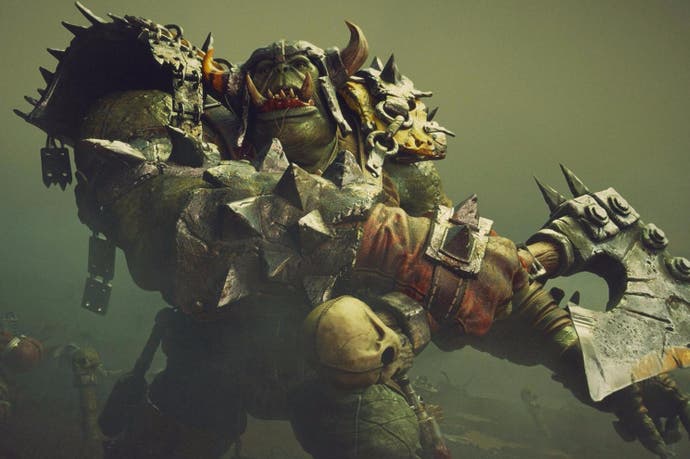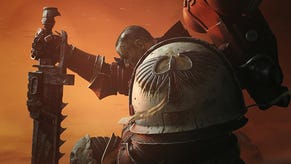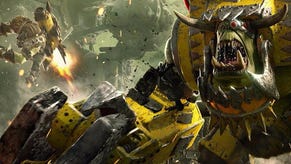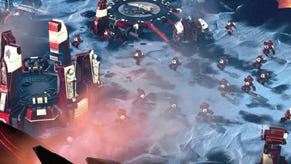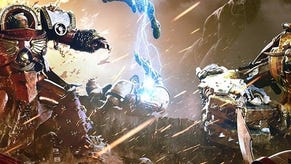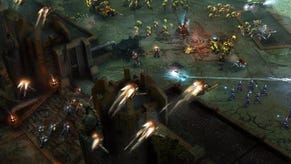How Dawn of War 3 uses MOBAs to modernise multiplayer RTS
Waaagh!
Dawn of War 3 is on the face of it a real-time strategy game, but dig a little deeper and the influence of the hugely popular MOBA genre is plain to see.
Ever since developer Relic Entertainment revealed the long-awaited sequel, players have noticed this MOBA influence. Up to this point, it's been felt in the game's focus on Elite units, which work similarly to, for example, the Champions from League of Legends. I've spoken with Relic about the Elites before, but to recap, Dawn of War 3's hero units are responsive, easy to see on the battlefield and have varied and impactful abilities.
But the MOBA influence on Dawn of War 3 extends further - deep down into the very core of the design of multiplayer.
At a recent event, I got the chance to play Dawn of War 3's multiplayer for a few hours, and left struck by just how much of its design felt influenced by the MOBA genre. And to Relic's credit, the developer does not shy away from this decision. In fact, it embraces it.
Dawn of War 3's multiplayer revolves around destroying the enemy's core, which is found inside its base. But to get to it, you must destroy a turret. To destroy a turret, you must destroy a shield generator.
There's a flow to competitive multiplayer that feels very MOBA. You can make a beeline for the enemy base, but it'll be so heavily defended by the incredibly powerful turrets that there's no real point. So, you need to play ball, picking a shield generator to destroy, which makes its associated turret vulnerable. Once that's destroyed, you've opened up a path to the base.
Remind you of anything?
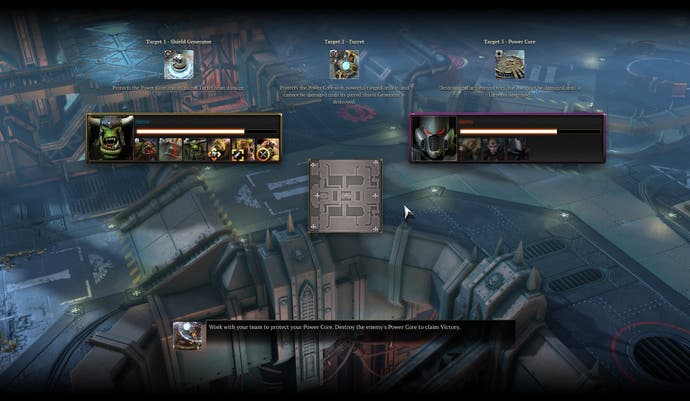
Then there's the design of the maps. The 2v2 and 1v1 maps I played all followed a three lane layout, with a clearly-defined top, mid and bottom. A shield generator protects a turret in each lane. Only two lanes, top and bottom, are viable to pursue early to mid game, though, because you need to bring down a bridge on either side of mid to reach the enemy base. Bringing this down takes a lot of time, so the action is funnelled to top and mid, concentrating fire and fuelling fights.
"MOBAs are definitely something we've looked at," Relic game designer Philippe Boulle tells me.
"When we went to make Dawn of War 3, specifically the multiplayer, we did spend some time looking at MOBAs and decided to pick and choose some lessons there. Obviously heroes with big, bold abilities is something MOBAs do quite well. What we liked about the objective in those games, and the lesson we took, is creating some specific places on the map that become concentrations especially for the late game - quick things you know you want to attack, you know you want to defend.
"Now, that creates places where we can make the gameplay space interesting. That's one thing. And it also gives some intermediary objectives. You're not going to rush into the opponent's base in the first minute because he has these big turrets that are going to stop you, but making a rush for a shield generator is a totally viable strategy."
Relic is going all in on the "destroy the core" objective for multiplayer. In fact, you can't play multiplayer any other way.
"That is the multiplayer game at launch," Boulle confirms. "Other modes are definitely something we want to explore post-launch, but at launch it's this power core gameplay mode."
What this means for the feel of Dawn of War 3's multiplayer is that it's a more dramatic affair. Yes, the base building, resource gathering and big armies of previous games in the series is present and correct, but you can tell the developers are trying to make this version of the game more immediately action-packed, with the potential for comebacks around every turn.
"The biggest danger for us in terms of making a really fun strategy game is dead man walking syndrome," Boulle explains, "where something happens early in a match, you know it's going to lead to victory or defeat, but you have to go through another half hour of play.
"We wanted you to be able to probe the opponent, to be able to take a generator, lose a generator and still come back from it."

Fuelling this feel is an under-the-hood mechanic called escalation. This divides up a multiplayer match into phases. In the early game, resource flow is relatively low, but losses are quite forgiving. As the escalation increases, the reimbursement goes down but the resource flow rises, and the health on generators, turrets and the power core increases.
So, early game you're encouraged to probe the enemy and perhaps get into combat without an early loss determining the match.
Talking of comebacks, all the races have a mechanic seemingly designed to trigger dramatic swings in momentum. You've probably seen one of these global powers before: the Space Marine's orbital laser strike obliterates all in its path, with a cool graphical effect to boot. But the Eldar's Eldritch Storm works similarly. The Orks' Rokz power is best though. It's basically the best game of hot potato you've ever seen - they drop a tractor beam beacon that any unit friend or foe can pick-up and move around the map. Pick it up and move it into the most dangerous place, or the place that's least dangerous. Things get really interesting when you pick up the beacon with a unit that can teleport - or Gorgutz, one of the Orks' Elite units, who can use his chain fist to leap big distances.
Those powers are an on-your-nose comeback mechanic, but the way each race plays at an even fundamental level seems to have it in mind. Let's look a little closer at the Orks. Yes, like previous versions of everyone's favourite cockney space aliens, Dawn of War 3's Orks are all about getting up in their opponent's face with overwhelming numbers. But this time around they have a cool new trick up their sleeve: scrap.
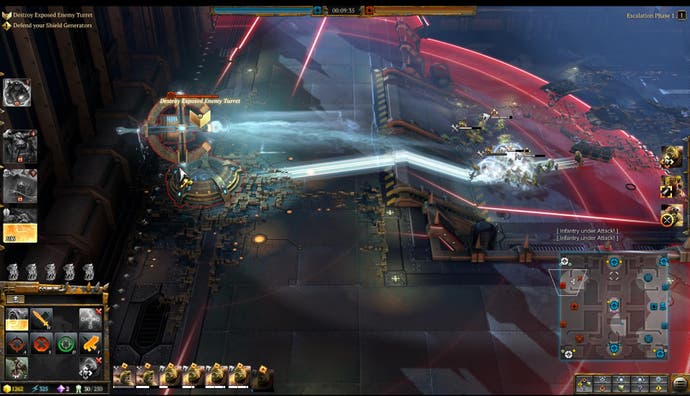
In Dawn of War 3, the Orks have ways to generate piles of scrap metal. Anytime a vehicle is destroyed they leave these piles, too. Orks can interact with them. Scra is like a secondary economy for them.
So, any Ork unit can upgrade by right clicking on a piece of scrap, and they'll gain new abilities specific for that unit. Boyz gain armour and more health, for example. Shoota Boyz gain grenades. Tankbustas can start summoning Bomb Squigs.
Gretchin, the Ork builder unit, can build vehicles at a discount and faster from the larger pieces of scrap. This sparks a cool late game situation where after a big fights with vehicles, Gretchin come in and start building Death Koptas, Deff Dreads and Killa Kans just from the mass of wreckage that's left behind. When you're on the receiving end of a surprise new army, it can feel like, where did this come from?! But when you play as the Orks and pull it off, it feels great - and it's perfectly in keeping with what I imagine the Orks should be about, lore wise.
And of course, scrap is a good comeback mechanic. It is, essentially, a way of turning the tide, or delivering forces in an unexpected way. All the races have them.
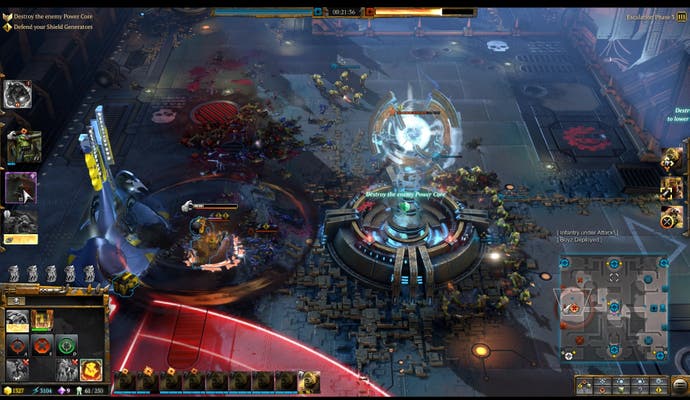
The most encouraging sign for me is that after playing Dawn of War 3 for four hours straight, I left wanting for more. It's a huge amount of fun, and whatever your take on the mechanics of the thing, what is certain is that Relic has once again nailed the Warhammer 40k feel. You can tell the studio lives and breathes 40k by the way the Orks move, by the way they stomp around, shouting at each other, beating their drums and screaming bloody murder. For years Relic has done 40k better than any other developer, and I see no reason why Dawn of War 3 will change that.
Not everyone will be enthused by this new direction for Dawn of War 3, and I get that. In truth, the game feels like a curious hybrid of not just RTS and MOBA, but of the first two Dawn of War games. It's an interesting mishmash of games and genres. Yes, it's different, but then it had to be I get the sense that Relic is taking a long-term view with Dawn of War 3, one informed by the hope the eSports community will pick it up. As interest in the RTS genre waned, Dawn of War had to change, and Dawn of War 3 is Relic's answer.
